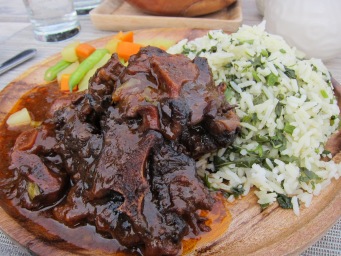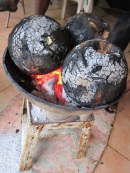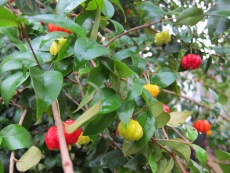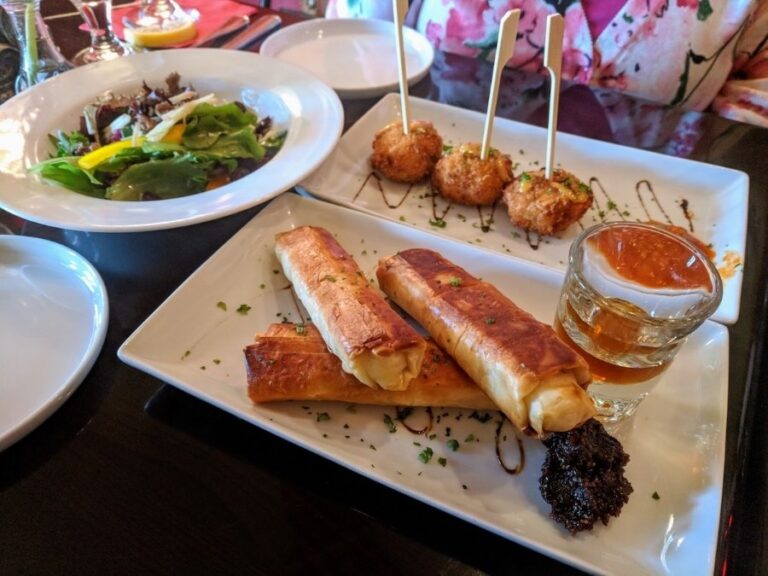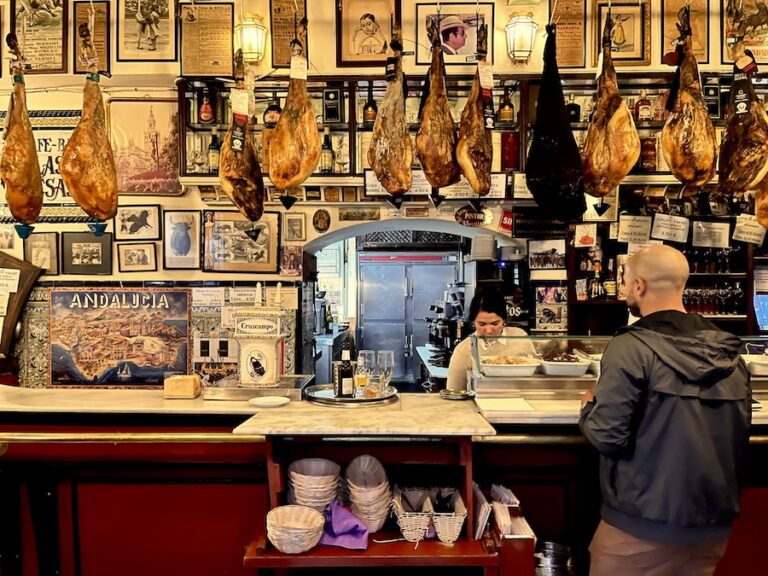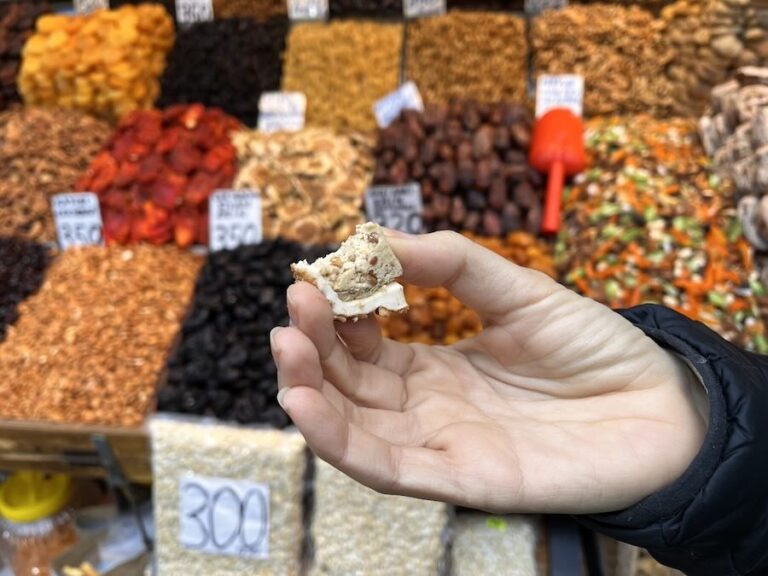Jamaican Eats: Must Try Food in Jamaica
We put together this list of must-try foods in Jamaica to help travelers experience the culture through typical Jamaican dishes. We also share some reflections on what we’ve learned about Jamaican food culture and traditions. Enjoy!
This post originally appeared on our personal blog while we were serving with Peace Corps in Jamaica in 2014. It has been revived here for our Jamaican culture series. Updated as of March 2021.
Must Try Foods in Jamaica
Discover Jamaican cuisine through some of our favorite meals and ingredients. If you’re visiting Jamaica and wondering what you should eat, add these dishes to your to do list!
Typical Jamaican Dishes
Ackee and Saltfish
The official national dish of Jamaica is ackee and saltfish. It is usually served for breakfast with a starch to balance out the salt.
Ackee is a fruit that almost resembles scrambled eggs when cooked. It can actually be poisonous if eaten before the shell of the fruit opens naturally (but don’t worry – Jamaicans know how it’s done).
Patties
Jamaican patties are the most common street food in Jamaica. It’s like hand pie with a flaky crust and fillings like curry or spicy beef inside.
Tastee Patties and Juici Patties are the two most well known fast food joints, and everyone has their personal preference.
We always eat our patties sandwiched inside coco bread (more on that shortly).
Rice and Peas
One of the most typical Jamaican side dishes is rice and peas. When I tutored at the local school, rice and peas was served nearly every day.
Outside of Jamaica, we would substitute the word “beans” for “peas”, as it’s not the little green peas we’re used to. Red beans are mixed in with rice, sometimes cooked in coconut milk (our favorite) until the rice becomes somewhat dry.
Jerk Chicken or Pork
Jerk cooking originated in Jamaica and it refers to cooking over smoke with a spicy dry rub or marinade that features spicy Scotch bonnet pepper and allspice.
Today in Jamaica, jerk chicken or pork is most often cooked in steel barrels. You’ll find jerk shacks along the streets of Jamaica but jerk is served in restaurants as well.
Fried Chicken
Though not often talked about, we found that most Jamaicans we know eat fried chicken with a frequency that might surprise you. We’d say it’s more common than jerk chicken. In fact, a visit to KFC is a popular treat for kids celebrating birthdays.
Most mom and pop shops serve fried chicken plate lunches, sometimes with a sauce that resembles BBQ and sometimes just breaded.
Run Down
Jamaican run down is a sweet and savory stew made with coconut milk, canned fish, and vegetables.
Festival
Festival is a slightly sweet, fried dumpling with a cornmeal base. It’s often served as a side when ordering street food or fast food. But it can also accompany ackee and saltfish at breakfast.
Other popular alternatives to festival as a side dish are bammy, a disk of ground cassava (yuca) that’s often fried, or fried dumplings without the sweetness, a.k.a. Johnny cakes.
Coco Bread
My favorite Jamaican treat was a good, buttery piece of coco bread. It’s made with flour and coconut milk with just a tiny bit of sweetness.
You’ll find coco bread in Jamaican bakeries or as an accompaniment to patties.
Devon House Ice Cream
Perhaps the most famous treat in Jamaica is ice cream from Devon House I Scream. The original store is located at Devon House in Kingston, the historic mansion owned by Jamaica’s first Black millionaire.
There are now multiple ice cream shop locations around the island, serving creamy concoctions with Jamaican flavors like rum and raisin, mango, guava, and soursop.
Must Try Fruits and Vegetables in Jamaica
Of course, there’s a plethora of delicious tropical fruits in Jamaica that we go nuts over. From papaya, mango, pineapple, bananas, and coconut to giant avocados, there are many fruits you probably recognize.
Some you may not recognize include star fruit, star apple, custard apple, sweetsop, soursop, and passion fruit. But these can be a little more difficult to find at times.
The following are vegetables and fruits that are more common around the island but may still be unfamiliar to many visitors:
Sorrel
Sorrel is a type of hibiscus flower that Jamaicans grow on the island. When dried out, the blossom looks like a dark maroon bell.
Sorrel is most often turned into a jewel-colored juice with sugar and ginger, especially during Christmas season.
Breadfruit
These big green balls drop from trees when ripe. But before the starchy yellow insides start to sweeten, breadfruit actually makes a great substitute for toast.
It can be prepared a variety of ways, including roasting, boiling, or frying. You’ll see breadfruit served on the side as a starch for breakfast, lunch, or dinner.
Callaloo
Callaloo became one of our favorite greens. It’s sometimes compared to spinach or collared greens. Once the stalks are removed, it’s boiled or fried, sometimes with other vegetables. We enjoyed mixing callaloo into our rice.
For adventurous eaters
We wanted to include this next list separately. Although we encourage everyone to try new things when traveling, we know some dishes will be more of a stretch for some people.
Curry Goat – This dish originates from Jamaica’s Indian population. Frequently served for special occasions, this spicy curry dish features goat meat and often comes with rice.
Oxtail – Cooked over a long period, tender oxtail meat makes for a rich, tasty stew or soup.
Escovitch Fish – Typically a whole fish, marinated overnight with a spicy Scotch bonnet sauce and topped with onions and carrots.
Jamaican Eats: Experiencing Culture Through Food
January 14, 2014: One of the best things about living abroad is trying all the new food that the country has to offer. If you are a Sociology geek such as myself, you’ll also love the rich cultural and historical context that food provides when getting to know a country. If you love to cook, learning a couple of local recipes is a great tool for integrating and earning respect.
Like many developing countries, Jamaican food is rich in tradition and it’s based upon what is available on the island. In its most simplified form, I’d sum up Jamaican cooking in 6 words: fresh, stewed, baked, steamed, fried, and jerked.
The food nerd in me could talk for days about all of this but I’ll do my best to give you the most common themes.
Fresh: Jamaica Growing Seasons
With a wide range of land and micro-climates, ample sun, rain, and fertile lands, Jamaica is blessed to have a 365 day growing period. While many still get their produce from a local open air market or grocery store, Jamaicans also tend to grow a fair number of fruits in their yards both intentionally and unintentionally (fruit discarded after being eaten).
It’s the variety of different fruit that really impresses me. Many Jamaican families make their own natural juices and everyone has a particular kind of mango they prefer.

Though many of the produce is grown here on island, it’s important to note that Jamaica does import produce, like grapes, brussel sprouts, and apples. As with most things, it’s best to buy and support local farmers. Plus imported foods are more expensive.
Here’s a general run down of the produce you can find in Jamaica.
Items Common to Us in the States – most items can be found year round unless otherwise noted
| Papaya | Bananas Different varieties | Pineapple Different varieties | Watermelon Different varieties |
| Cantaloupe | Onions | Potatoes | Tomatoes |
| Green Pepper | Carrots | Green Onion/Escallion | Yam |
| Sweet Potatoes | Pumpkin/Squash Less like pumpkin, more like squash. | Pear/ aka. Avocado (s) Imagine supersized Mexican/Cali hass variety. So good. | Mango (s) many varieties |
| Pap Chow/Bok Choi | Hot Peppers Mostly Scotch Bonnet but other varieties as well | Cabbage | Corn more tough, not as sweet |
| Cho Cho/a chayote Super versatile vegetable and cheap. | Cucumber | Eggplant | Zucchini |
| Lettuce | Apples (i) | Strawberries (i) | Cauliflower |
| Garlic (i) | Broccoli | Grapes (i) |
(s) – indicates seasonal
(i) – indicates imported items
Items Uncommon to Us in the States – Most of these items are seasonal unless otherwise noted
| Otaiti Apple (Jamaican Apple) Great for juice and eating. Typically cheap. Seasonal. | Custard Apple Mushy texture but interesting flavor. | Star Apple Great tasting but skin my cause allergic reaction | Star Fruit Great for juice and eating |
| Passion Fruit Great for juice | Guava Great for juice and marinades | Jack Fruit Huge, strange looking fruit. Taste like bubble gum | Plantain Like a giant banana. When fried ripe it’s sweet. When frying an un ripe one, it’s like a french fry/potato |
| Sour Sop Great for juice and eating | Sweet Sop Great for juice and eating | Cherries Not the kind you see in the states but used in the same way. | Neesberries Like eating brown sugar. Some love it. |
| Ackee A fruit used in the national dish. Texture like scrambled eggs. Good cooked. | Calaloo/Collard Greens (y) Many will say it’s like spinach. It’s not. It’s like collard greens. | Breadfuit Roasted and friend makes this takes like fries. Great with stews. |
(y) – Found year round
Jamaican Cuisine: A Literal Melting Pot
Jamaicans love to stew things. They love hot soups (even in hot weather). I wonder if this is tied to British culture, left over from colonial days.
Stewing is also a great way to cook tough cuts of meat that are considered to be cheap and easily accessible. You’ll find that a lot of the meat sold in stores and at the market are chunks of meat, not the fancy cuts you find in butcheries in other developed countries. These chunks and parts of meat are slowly stewed over hours and the sauce made is often thickened to make a gravy. I’m talking about parts like cow feet, pig’s tail, chicken back, turkey neck, pork, chicken, and my beloved oxtail (all with bones included). Over rice, it’s one of my favorite things to eat. Anywhere.
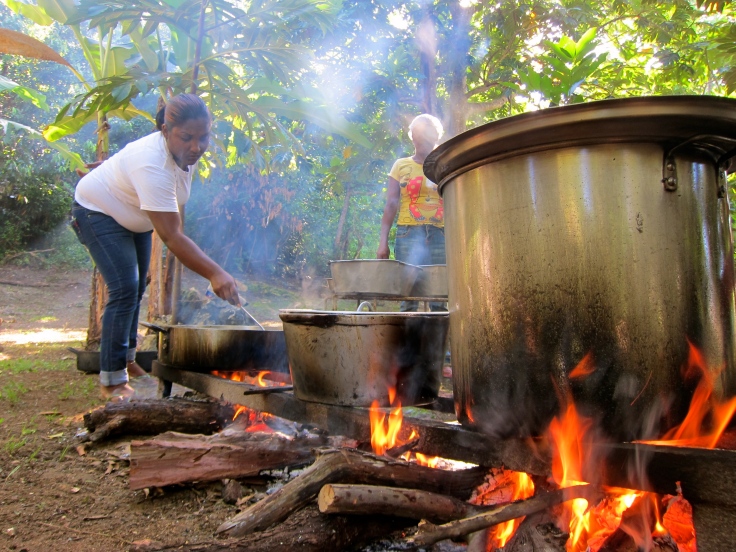
The melting pot metaphor also refers to the mixing of different cultures and their influences on the country’s cuisine.
One of the most popular things you’ll find in Jamaica is the use of curry. Curried chicken is ubiquitous in cookshops all over the island and curried goat/mutton is a holiday favorite and treat.
The use of curry comes from the the Indian immigrants that came decades ago as indentured servants and sugar plantations workers after slavery was abolished.
Frying Foods in Jamaica
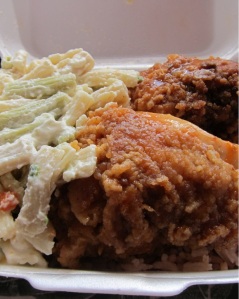
Similar to stewing, frying is an important cooking method related to the the historical context of using what you have and what you have access to.
Jamaicans fry a lot of things. They fry fish, breadfruit, plantains, roti (Indian flat bread), fritters, festival (fried bread), and my favorite: chicken.
Frying is an easy cooking method and though unhealthy in some regards, frying is a way to make sure your food is fully cooked. This was important for Jamaicans who didn’t have access to fridges or freezers like they do now.
Also, frying requires oil, fire, and a pot- things accessible to most families. Many still use gas or wood stoves for cooking. Electricity- and thus, electric stoves- were not common back in the days and so a culture of cooking around frying and stewing was cultivated.
That’s not to say that baking doesn’t exist in Jamaica today, but it’s just not as common of a practice compared to stewing and frying.
—
These are just some oversimplified and generalized themes I noticed about Jamaican cooking in my time living there.
It’s been fun and tasty to learn about Jamaican cooking. I’ve enjoyed tasting, but more importantly learning how to cook local favorites that I’ll take home with me to share with family and friends on our return. I’ve enjoyed cooking so much that another volunteer and I started a blog to document our and our fellow volunteer’s food adventures in Jamaica – http://pcjcookshop.wordpress.com/
All this talk of food is making me hungry. Till next time.
-J
What travel restrictions and rules are in place in Jamaica?
Find post-pandemic travel updates for Jamaica here:
What you need to know about Jamaica travel right now
Other Posts in the Jamaican Culture Series:
Jamaican Culture Series & Jamaica 101 Video
Life Lessons from 5 Jamaican Sayings
Jamaica Travel Info:
How to Get Around in Jamaica: A Guide to Public Transit vs. Rental Cars
Where to Stay in Jamaica
Favorite Places to Visit in Jamaica: Off the Beaten Path
8 Packing Essentials for Jamaica
Reggae Marathon in Negril, Jamaica
Jake’s Off-Road Triathlon: Treasure Beach, Jamaica
Galina Breeze Hotel in St. Mary, Jamaica
Attractions in Jamaica Worth Your Money


